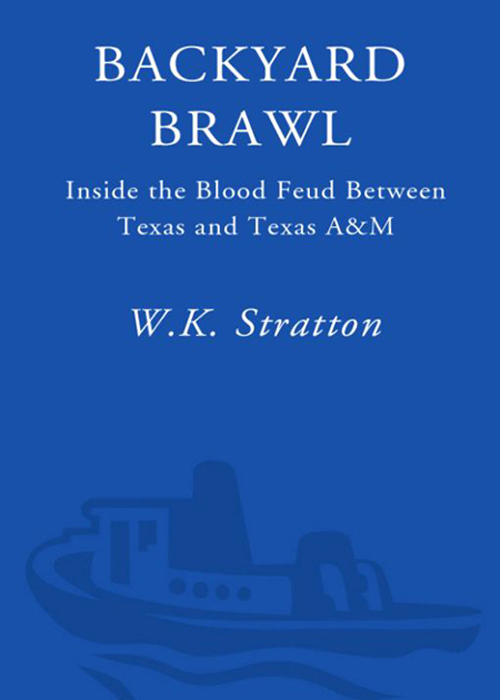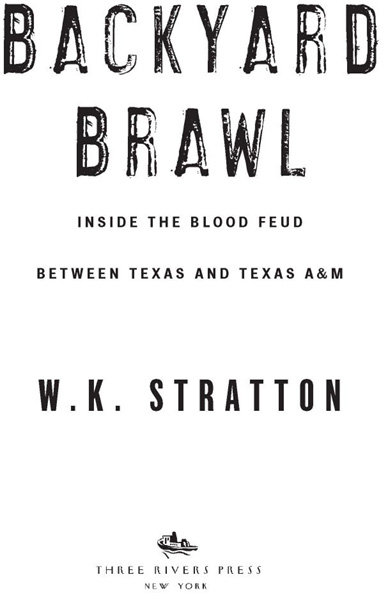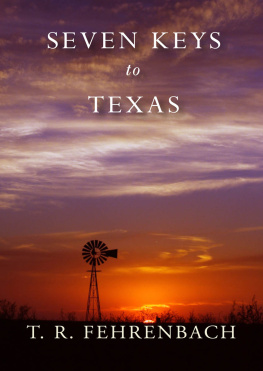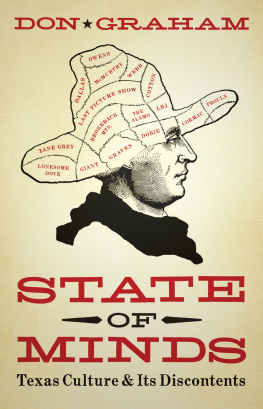

Table of Contents
For my parents;
for Luscaine and Kimberly;
and for Jan Reid
You just cant live in Texas if you dont have a lot of soul...
DOUG SAHM
Backyard Brawl is as much about people, culture, and history as it is about football; Stratton draws out the details and emotions of each in a style that is more like talking with friends than reading a book. Even as he includes some of the dirt about each school, his overall tone is one of respect and admiration. For anyone who likes footballand for many who dontthis book will be a winner. Daily Oklahoman
Money, power, and football dominate Texas culture, and nowhere is that truth revealed more than in the rivalry between Texas and Texas A&M. In Backyard Brawl, W. K. Stratton takes you inside the crazed intensity of the conflict between the hippie freaks (Texas) and the sheep-loving rednecks (A&M) and produces a compelling portrait of both college football at the highest levels and the contemporary state of affairs in Texas. Peter Gent, author of North Dallas Forty and TheFranchise
W. K. Strattons Backyard Brawl runs to daylight and takes its place with the all-time best literature on college football. You dont have to be a maroon-underweared Aggie or a burnt-orange jockstrap Longhorn to love it, but itll help. Dan Jenkins, author of Semi-Tough
Texas versus Texas A&M ranks among the great college football rivalries, right up there with ArmyNavy and HarvardYale. Stratton presents the rivalry as though it were a Texas tall tale, passed along over a couple of longneck Lone Stars at a Lubbock roadhouse. Funny, intelligent, insightful, and just a little Texas crazygreat reading. Booklist
Stratton weaves a story that is informative and entertaining as he takes readers inside both universities and mines the lode of football lore therein. Bryan-College Station Eagle
A savvy sportswriter uses the football rivalry between the University of Texas and Texas A&M to paint a lively, partial portrait of the Lone Star State. Good-natured, intelligent, funny. Kirkus Reviews
A fine book to learn something new about a subject you probably think you know everything about already. Alcalde, magazine for Texas Exes (University of Texas alumni association)
Preface:
The Nature of the Thing
One afternoon in the fall of 2001, Texas A&M University President Ray Bowen sat in his office discussing with a visitor one of the 125-year-old schools most recent accomplishments, its induction into the Association of American Universities (AAU). The prestigious organization represents the sixty-three best research universities in the United States, private and public. A&Ms name appears alongside Harvard, Yale, Stanford, Cornell, Columbia, Michigan, Cal Berkeley, Emory, Johns Hopkins, MIT, and other educational stars in the organizations roster, and that signifies A&Ms arrival as one of Americas outstanding universities. Bowen pointed out that A&M had been selected for membership thanks in part to help from the University of Texas in Austin, itself a member since 1929. (The only other Texas school in the AAU is Rice University.) Bowen said A&Ms AAU membership was an example of the friendship and cooperation between Texass two largest universities, and he smiled while saying it.
An hour or so later, the same visitor listened to the commandant of A&Ms Corps of Cadets complain about the vandalism to his car occurring when the Aggie football team visited Austin to play the UT Longhorns in 1996. Every car with an A&M bumper sticker in the parking lot of the Hilton there in north Austin had its tires slashed, the commandant said, bewilderment and anger still in his voice five years later. Still later in the day, three senior cadets told of their experience in Austin in 2000: There was some drunk UT fan who spray-painted my Fish [freshmen cadets] orange while we were in formation, one said. This guy must have been forty years old. So Im wondering. Why did you just do that? And Im thinking, Man, youre old enough to be my dad.
There you have it. The yin and the yang of the relationship between UT and A&M. On the one hand, cooperative friends working toward the common goal of providing outstanding public higher education in Texas. On the other, bitter rivals who scarcely can stomach each other.
The schools and their partisans are not unlike brothers who squabble at just about every opportunity that avails itself to squabbling. UT can be seen as the son Mom always liked best, the one who got the new bike, the better clothes, and a larger allowanceand who gloated about it. A&M can be seen as the son with the chip on his shoulder who got the hand-me-downs and leftoversand who stewed about it. For generations, disparity did exist between UT and A&M in size, quality of education, and funding as well as football prowess. Now the two are much closer, both among the ten largest universities in the United States, both with huge alumni bases, both with excellent academic reputations: UT and A&M tied for fifteenth in U.S. News & World Reports 2002 ranking of the best public universities in the nation, just behind Penn State. Yet while both schools should revel in receiving such a high grade, the appearance of the the U.S. News rankings stuck in the craw of both Longhorns and Aggies. How could they be ranked as an equal with us?
Each year, the rivalry between the two schools peaks on the Friday after Thanksgiving, when the Longhorns and Aggies battle it out in a home-and-away football series that currently is the third-most-played rivalry among major college football teams (Lafayette-Lehigh, Yale-Princeton, and Harvard-Yale having been relegated to the minor leagues). It also is the oldest intrastate rivalry among major college football teams. Typically the game winds up on television, either on one of the networks or on cable. Though years passed without the game playing a significant role in determining the national champion, UT-A&M resonates in special ways. The football on the field is spirited and hard-assed, make no mistake about it. The surrounding spectacle, especially when the game occurs at Kyle Field in College Station, is unlike anything else encountered in college football. The expectations placed on the players are incredible. And the whole world seems to be watching. Its a big stage, said one All-America Longhorn. People who go to Texas or A&M and dont understand the stage are going to be disappointed. Its not easy. Its a crazy environment to be in.
And of course UT-A&M goes beyond good football and astonishing exhibition. Despite the similarities between the two universities, the differences prevail. The game is a time when two competing cultures come face-to-face in combat for three hours. On one level, it can be Viewed as a kind of morality play, with a lot of snot-loosening hits thrown in for good measure: hippie liberals vs. cattle-loving hicks. Aggies look at themselves as representing the values of small towns and rural areasGod, home, and country. Longhorns, on the other hand, see themselves as the epitome of sophisticationprogressive, open-minded, worldly. Like it or not, the players on the field are imbued with political and ethical values as much as they are burnt orange or maroon. If the Longhorns win, the Orangebloods can lean back smugly, take a sip of single-malt scotch (or of beer), wink at God, and think, yes, everything is all right in the universe, just as it should be. If the Aggies win, partisans of the maroon Fightin Farmers are whoop-whooping and chugging beer (or single-malt scotch) in every corner of the globe, celebrating not just a victory on the playing field but also the advances their university has made over the past three decades (advances that are impressive as hell) to lay claim to being
Next page








